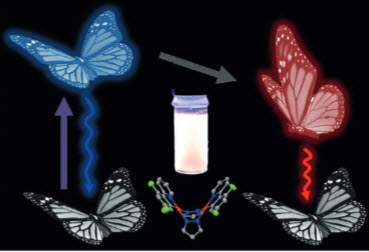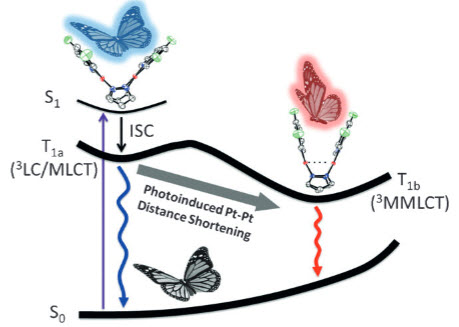‘Butterfly’ molecule could lead to new sensors, photoenergy conversion devices
September 2, 2014

A phosphorescent molecular “butterfly” that can generate dual (white) emission upon photoexcitation (credit: M. Han et al./Angewandte Chemie)
A novel molecule that can take your temperature, emit white light, and convert photon energy directly to mechanical motions has been enhanced by Florida State University researchers.
Biwu Ma, associate professor in the Department of Chemical and Biomedical Engineering in the FAMU-FSU College of Engineering, created the molecular structure resembling a butterfly in a lab about a decade ago, but has continued to discover it has many other unique capabilities, described in the latest edition of the journal Angewandte Chemie.

Potential-energy curves and transitions for the molecular butterfly molecule involving a photoinduced structural change as a result of photoinduced Pt–Pt distance shortening, and generation of dual emission (credit: M. Han et al./Angewandte Chemie)
For example, the molecular butterfly can flap its “wings” and emit white light (it actually switches from blue to green to red in picoseconds or less). Creating white light usually takes several different luminescent molecules to achieve. It’s also extremely sensitive to temperature, which makes it a thermometer, registering temperature change by emission color.
“To our knowledge, this is the first example of a white phosphorescent molecule based on the formation of two distinct excited states by a photoinduced structural change,” the researchers say in the paper.
Ma and his team are looking at creating noninvasive thermometers that can take better temperature readings on infants, nanothermometers for intracellular temperature mapping in biological systems, molecular machines operated simply by sunlight, and methods of measuring solid-liquid phase change and viscosity.
Abstract of Angewandte Chemie International Edition paper
A butterfly-like phosphorescent platinum(II) binuclear complex can undergo a molecular structure change in which the Pt–Pt distance shortens upon photoexcitation, which leads to the formation of two distinct excited states and dual emission in the steady state, that is, greenish-blue emission from the high-energy excited state at the long Pt–Pt distance and red emission from the low-energy excited state at the short Pt–Pt distance. This photoinduced molecular structure change has a strong dependence on the molecule’s surrounding environment, allowing its application as self-referenced luminescent sensor for solid–liquid phase change, viscosity, and temperature, with greenish-blue emission in solid matrix and rising red emission in molten liquid phase. With proper control of the surrounding media to manipulate the structural change and photophysical properties, a broad white emission can be achieved from this molecular butterfly.